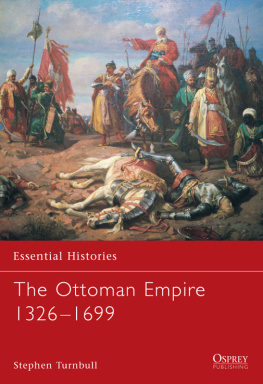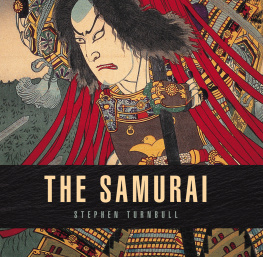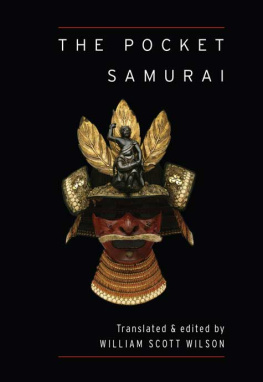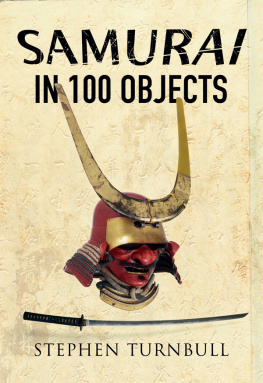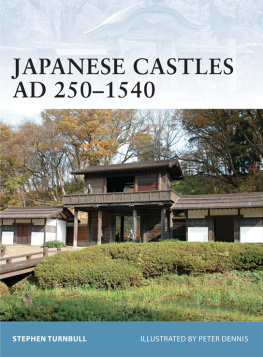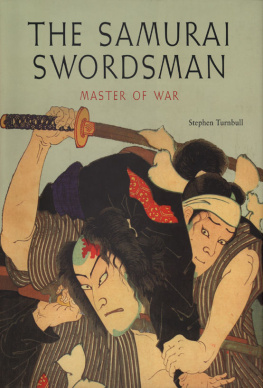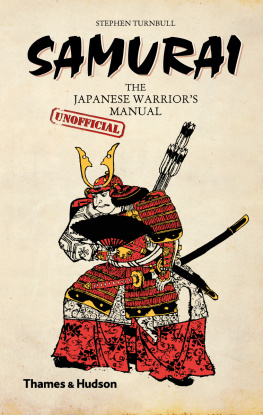Turnbull - The art of the samurai swordsman
Here you can read online Turnbull - The art of the samurai swordsman full text of the book (entire story) in english for free. Download pdf and epub, get meaning, cover and reviews about this ebook. City: London;Japan, year: 2007, publisher: Tuttle Publishing;Greenhill, genre: Non-fiction. Description of the work, (preface) as well as reviews are available. Best literature library LitArk.com created for fans of good reading and offers a wide selection of genres:
Romance novel
Science fiction
Adventure
Detective
Science
History
Home and family
Prose
Art
Politics
Computer
Non-fiction
Religion
Business
Children
Humor
Choose a favorite category and find really read worthwhile books. Enjoy immersion in the world of imagination, feel the emotions of the characters or learn something new for yourself, make an fascinating discovery.
- Book:The art of the samurai swordsman
- Author:
- Publisher:Tuttle Publishing;Greenhill
- Genre:
- Year:2007
- City:London;Japan
- Rating:4 / 5
- Favourites:Add to favourites
- Your mark:
- 80
- 1
- 2
- 3
- 4
- 5
The art of the samurai swordsman: summary, description and annotation
We offer to read an annotation, description, summary or preface (depends on what the author of the book "The art of the samurai swordsman" wrote himself). If you haven't found the necessary information about the book — write in the comments, we will try to find it.
The art of the samurai swordsman — read online for free the complete book (whole text) full work
Below is the text of the book, divided by pages. System saving the place of the last page read, allows you to conveniently read the book "The art of the samurai swordsman" online for free, without having to search again every time where you left off. Put a bookmark, and you can go to the page where you finished reading at any time.
Font size:
Interval:
Bookmark:

BIBLIOGRAPHY
Ackroyd, Joyce. Women in Feudal Japan. Transactions of the Japan Society of London (1957), 3168.
Aizu han to Shinsengumi. Tokyo, 2003.
Allen, Louis. Death and Honour in Japan. The Listener 24 (June 1976).
______. Burma: The Longest War. London, 1984.
Bakumatsu Ishin Taisens. Tokyo, 2004.
Various authors. Bakumatsu Kenshinden (Rekishi Gunz Series, vol. 56), Tokyo, 1998.
Beholder. Fudebakudo: The Way of the Exploding Pen.
Fetcham, 2003.
Birt, Michael P. Warring States: A Study of the Go-Hj Daimy and Domain 14911591. PhD diss., Princeton University, 1983.
Bit, Masahidee. The Ak Incident (17011703). Monumenta Nipponica 58 (2003), 149169.
Blomberg, Catharina. The Heart of the Warrior: Origins and Religious Background of the Samurai System in Feudal Japan. Folkestone, Kent: Japan Library (Curzon Press), 1994.
Bottomley, Ian and Jock Hopson. Arms and Armour of the
Samurai. London, 1988.
Boxer, C. R. Notes on Early European Military Influence in Japan (15431853). Transactions of the Asiatic Society of Japan 8, 2nd ser. (1931), 6893.
Brownlee, John. The Shky War and the Political Rise of the Warriors. Monumenta Nipponica 24 (1969), 5977.
Buck, James H. The Satsuma Rebellion of 1877: From Kagishima through the Siege of Kumamoto Castle. Monumenta Nipponica 28 (1973), 427446.
Butler, Kenneth. The Heike Monogatari and the Japanese Warrior Ethic. Harvard Journal of Asian Studies 29 (1969), 93108.
Callahan, Caryl. Tales of Samurai Honor: Saikakus Buke Giri Monogatari. Monumenta Nipponica 34 (1979), 120.
Conlan, Thomas D. In Little Need of Divine Intervention: Takezaki Suenagas Scrolls of the Mongol Invasions of Japan. Cornell University, 2001.
______. State of War: The Violent Order in Fourteenth-Century Japan. Ann Arbor, Michigan: Center for Japanese Studies, University of Michigan, 2003.
Daidji, Yuzan. Bud Shshinsh. Tokyo, 1941.
Dautremer, J. The Vendetta or Legal Revenge in Japan. Transactions of the Asiatic Society of Japan 13 (1885), 8289.
Delgado, James P. Relics of the Kamikaze. Archaeology
56, no. 1 (2003), 2642.
Farris, Wayne W. Heavenly Warriors: The Evolution of Japans Military, 5001300. Cambridge, Massachu setts: Harvard University East Asia Center, 1992.
Fogel, Joshua A., ed. Sagacious Monks and Bloodthirsty Warriors: Chinese Views of Japan in the Ming-Qing Period. Norwalk, Connecticut: EastBridge, 2002.
Friday, Karl F. Hired Swords: The Rise of Private Warrior Power in Early Japan. Palo Alto, California: Stanford University Press, 1992.
______. Legacies of the Sword: The Kashima Shinry and Samurai Martial Culture. Honolulu: University of Hawaii Press, 1997.
______. Samurai, Warfare and the State in Early Medieval Japan. New York: Routledge, 2004.
Fukushima, Shoichi. Bushido in Tokugawa Japan: A Reassessment of the Warrior Ethos. PhD diss., UC Berkeley, 1984.
Gempei Kassen Jimbutsuden. Tokyo, 2005.
Goble, Andrew E. War and Injury: The Emergence of Wound Medicine in Medieval Japan. Monumenta Nipponica 60 (2005), 297338.
Hagio, N. Shinsengumi Shiseki Kik. Tokyo, 2003.
Hagiwara, S. Yagi Bushi ni mo utawareta Chji no Isabur koroshi, in Keng to Otokodate (Raibaru Gekitotsu Nihon shi, vol. 7), Tokyo, 1979, 114117.
Harada, T. Shint-ry hitotsu no tachi no gokui, in Keng to Otokodate ( Raibaru Gekitotsu Nihon shi, vol. 7), Tokyo, 1979, 3645.
______. Sait Denkib to Sakurai Kasuminosuke, in Keng to Otokodate ( Raibaru Gekitotsu Nihon shi, vol. 7), Tokyo, 1979, 39.
Hawley, Willis. Introduction to Japanese Swords. Los Angeles, 1973.
Hawley, Willis, ed. Heih Okugish: The Secret of High Strategy: Yamamoto Kansuke. Los Angeles, 1994.
Hazard, Benjamin H. The Formative Years of the Wak, 122363. Monumenta Nipponica 22 (1967), 260277.
______. Japanese Marauding in Medieval Korea: The Wak Impact on Late Kory. PhD diss., Berkeley, 1967.
______. Wak. Encyclopaedia of Japan 8 (1982), 220221.
Hearn, Lafcadio. Japan: An Interpretation. Rutland, Vermont: Charles E. Tuttle Co., 1955.
Henthorn, William A. Korea, the Mongol Invasions.
Leiden, 1963.
Hillsborough, Romulus. Shinsengumi: The Shoguns Last Samurai Corps. Rutland, Vermont: Tuttle Publishing, 2005.
Honda, F., et al. Kobud no hon. Tokyo, 2002.
Hori, Kyotsu. The Mongol Invasions and the Kamakura Bakufu. PhD diss., Columbia University, 1967.
Hurst, G. Cameron. Armed Martial Arts of Japan: Swordsmanship and Archery. New Haven, Connecticut: Yale University Press, 1998.
Imamura, Yoshio. Nihon Bud Zensh. Tokyo, 1962.
Inagaki, S. Bunky no Ansatsusha, in Gekid no Bakumatsu Ishin ( Raibaru Gekitotsu Nihon shi, vol. 5), Tokyo, 1979, 42.
______. Dai Tonegawa Hara no Kenka, in Keng to Otokodate ( Raibaru Gekitotsu Nihon shi, vol. 7), Tokyo, 1979, 122124.
______. Yjimb no hanashi, in Keng to Otokodate ( Raibaru Gekitotsu Nihon shi, vol. 7), Tokyo, 1979, 125.
Ise, Sadatake. Gunyki . Edo, 1843.
Ishiyamadera engi emaki. Ishiyamadera, 1996.
Jansen, Marius B. Sakamoto Ryma and the Meiji Restoration. Palo Alto, California: Stanford University Press, 1971.
______. Warrior Rule in Japan. Cambridge: Cambridge University Press, 1995.
Joly, H. L. Legend in Japanese Art. London, 1908.
Kammer, Reinhard. The Way of the Sword: The Tengu Geijutsu-ron of Chzan Shissai. London, 1978.
Kawachi, Kunihira. Nihont no Miryoku. Tokyo, 2003.
Kellogg, Edward. Selective Translation of Hgen Monogatari. Transactions of the Asiatic Society of Japan 45 (1917).
Ketsu makoto: Shinsengumi (Rekishi Gunz Series, vol. 31), Tokyo, 1992.
Knutsen, Roald M. Japanese Polearms. London: Holland Press, 1963.
Kobe. Yamanaka Shikanosuke to Tarakai Okaminosuke Katsumori, in Sengoku no Guny ( Raibaru Gekitotsu Nihon shi, vol. 3), Tokyo, 1979, 123.
Kofujita, Toshisada. Ittsai Sensei Kenposh, in Hiroto Saigusa and Akira Miyagawa, Nihon Tetsugaki Shis Zensh 15, Tokyo, 1957.
Komatsu, S. Heny Tsushima-Iki Sakimoro Shi. Tsushima 2000.
Ksaka, Danj. Ky Gunkan, in Sengoku Shiry Sosh, series 1, Tokyo, 1965.
Kzaki, A. Nij hachinen o tsuiyashite honkai o togeru, in O-ie sd to katakiuchi ( Raibaru Gekito tsu Nihon shi, vol. 6), Tokyo, 1979, 5860.
______. Shimada Tora no suke to Inoue Gensai, in Keng to Otokodate ( Raibaru Gekitotsu Nihon shi, vol. 7), Tokyo, 1979, 73.
______. Chiba Shsaku to Takayanagi Matashichir, in Keng to Otokodate ( Raibaru Gekitotsu Nihon shi, vol. 7), Tokyo, 1979, 7476.
______. Kens Jitsuryoku Dai-ichininsha no Gozen Shiai in Keng to Otokodate ( Raibaru Gekitotsu Nihon shi, Vol. 7) Tokyo, 1979 pp. 7883.
______. Machi Hikeshi to Daimy Hikeshi no Komy Arasoi, in Keng to Otokodate ( Raibaru Gekitotsu Nihon shi, vol. 7), Tokyo, 1979, 119121.
Kunihika, S. Miyamoto Musashi no Issei, in Keng to Otokodate ( Raibaru Gekitotsu Nihon shi, vol. 7), Tokyo, 1979, 2631.
______. Machi yakko to Hatamoto yakko no Gekitotsu, in Keng to Otokodate ( Raibaru Gekitotsu Nihon shi, vol. 7), Tokyo, 1979, 108110.
Kuwada Tadachika ed. Shinchkki. Tokyo, 1966.
Lindsay, K. and J. Kano. Jiu-jutsu. Transactions of the Asiatic Society of Japan 16 (1889).
Matsuno, Tsuneyoshi. Wives of the Samurai. New York: Vantage Press, 1989.
McCullough, Helen Craig, trans. The Taiheiki: A Chronicle of Medieval Japan. New York, 1959.
McCullough, William. ShkykiAn Account of the Shky War of 1221. Monumenta Nipponica, 186221.
______. The Azuma-kagami account of the Shky War. Monumenta Nipponica 23, 102155.
McMullen, James. Confucian Perspectives on the Ak Revenge. Monumenta Nipponica 58 (2003), 293315.
Font size:
Interval:
Bookmark:
Similar books «The art of the samurai swordsman»
Look at similar books to The art of the samurai swordsman. We have selected literature similar in name and meaning in the hope of providing readers with more options to find new, interesting, not yet read works.
Discussion, reviews of the book The art of the samurai swordsman and just readers' own opinions. Leave your comments, write what you think about the work, its meaning or the main characters. Specify what exactly you liked and what you didn't like, and why you think so.


